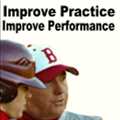The Baseball Swing - Rotational Hitting Explained
By Nate Barnett
It seems like baseball instruction in the area of hitting mechanics is splitting into two different camps. Rotational hitting
vs. Linear hitting. If you're new to the baseball world, or are just unfamiliar with the new exciting terminology, let me
offer some explanation.
Rotational Hitting
The purpose of the baseball swing is to transfer the most energy into the baseball as possible. In order to get the most
energy created, there are specific parts of the body that need to move at the correct time in order for this energy to occur.
A rotational approach offers that the energy used in creating a powerful baseball swing stems from the back side of the
body, and more specifically the lower half of the back side. The controlled chain reaction that happens when the back side
is moved at precisely the correct time toward the pitch is quite powerful. On the flip side, incorrect timing of the back
knee and hip will produce a sluggish bat.
A rotational approach to hitting uses the follow steps to a good baseball swing:
1. A good weight shift to the back leg from the stance position as a hitter is preparing to hit. Make sure that this weight
shift is not purely horizontal in motion, since this will create an imbalance.
2. The next step is the trigger. This is the most important movement that separates a rotational hitter from a linear hitter.
The triggering process should begin with the back knee turning and moving towards the pitcher (as apposed to simply spinning
in place). The back hip will quickly follow the back knee in the rotation process. Lastly, the hands will begin to enter into
the hitting zone. It's important that the hands do not begin the swing since the power is stemming from the back knee and
hip. Early hand movement would negate any effort to use energy from the back side of the hitter's body.
3. As the bat enters the zone, one will begin to see signs that a rotational approach has been utilized. The common tell
tale signs are the balance points. The easiest to explain in writing is that upon contact with the pitch there will be vertical
alignment with the inside shoulder joint, the back hip, and the back knee joint. This alignment shows that balance is retained
and no weight has shifted forward onto the front foot (more of a linear style).
As an aside, rotational hitting is used by most major colleges and a vast majority of Major League hitters. It provide
balance and power to the baseball swing.
About the Author
Nate Barnett is owner of BMI Baseball http://bmibaseball.com and is based out of Washington State. His expertise is in
the area of hitting, pitching, and mental training. Coach Barnett's passion is working with youth in helping expand their
vision for their baseball future. After finishing a professional career in the Seattle Mariners Organization, Nate pursued
his coaching and motivational training career. His instructional blog is located at http://bmibaseball.com/blog
His new FREE ebook, Toxic Baseball: Are you polluting your game? can be found on the main BMI Baseball website.
Hitting 101, an ebook on complete hitting mechanics will be released by June 1st, 2008. Features include numerous illustrations,
video clips, and a special offer to discuss your hitting questions over live on the phone strategy sessions.

